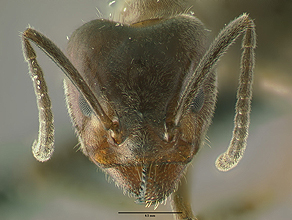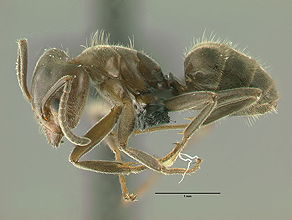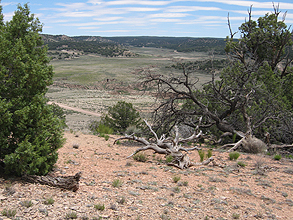- Identification
- Polymorphic workers. Light yellow-brown to dark brown with an abundance of short erect to appressed hairs. The body is covered with a dense pubescence, a feature that partially explains the common name for ants in this genus - "velvety tree ants." Liometopum apiculatum can be separated from the co-occurring congener Liometopum luctuosum by a number of features: the workers are lighter relative to the darker colored luctuosum, the hairs on the top of the pronotum are longer and more abundant, and the largest workers in a colony are noticeably larger than the largest luctuosum workers.
- Biology
- Liometopum apiculatum exist in populous colonies. They can form long and very busy trails that are used for foraging or to connect segments of their polydomous nest. Established trail routes can persist for many years (Shapley 1920). Foraging columns can also be located under the ground and litter, surfacing underneath ground level objects such as rocks and downed wood.
- additional biology notes...
- Distribution
- Range
- United States, Mexico. Southwestern United States and from northwestern to southeastern Mexico.
- Navajo Reservation Records
- Liometopum apiculatum are common in the Utah Juniper and Pinyon Pine woodlands on Black Mesa. Workers can be identified by the long erect hairs on the pronotum. If disturbed in the field, these ants will emit a strong noxious odor. Workers are polymorphic with the largest individuals approaching the size of small Formica workers.
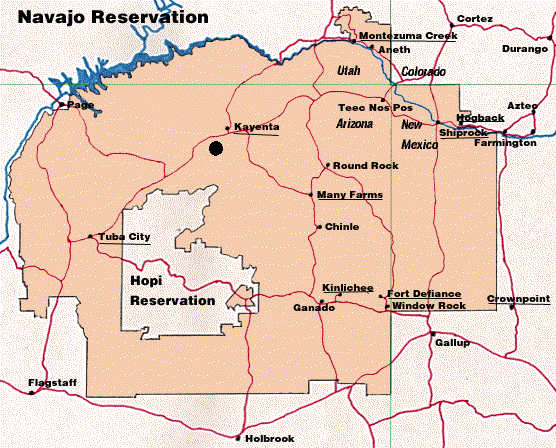
- Additional Notes
- Large colonies of up to 85,000 individuals and aggressive workers help make Liometopum apiculatum a dominant species in its favored habitats.
They are abundant in various oak habitat associations that occur from 1000 - 2500 m and in some high elevation (~2000 - 2500 m) pinyon pine, ponderosa pine and riparian areas.
- Foragers are opportunistic and will prey upon other organisms. Workers are highly excitable and when a colony or nest fragment is disturbed they burst forth, emitting a noxious alarm pheromone, and quickly swarm upon any unwitting myrmecologists found near the nest. Colonies are rarely investigated because both finding and excavating a nest can be difficult. Foraging trails often disappear into inaccessible holes (e.g. around the roots at the base of a tree) or into a cavity that is more a satellite location where some workers congregate rather than a part of the nest. Workers disappearing under a rock that can be flipped over, for example, are typically found to be using the covering object to make their way into one of their underground trails. In some cases these cavities will contain numerous workers, but no brood, and digging reveals there are no additional nest chambers nearby. When the main section of the nest is found, or suspected to be located, it may be situated in a tree bole or under a large rock.
- Liometopum apiculatum queens are among the largest North America ants. Their large size is likely an adaptation for claustral nest founding in what can be a harsh environment for most insects.
- Associations with other species
- Unusual and Noteworthy
- Liometopum apiculatum brood are a Mexican delicacy known as "escamoles." This food was once used as tribute presented to Aztec Emperors. Today the market demand for brood can be so high that local ant populations of this species are reduced by overcollecting. A typical meal that serves up escamoles is 2 tacos with ~ 50 grams of ants. "They are served fried or with black butter, but the best way is fried with onions and garlic."
- Description
- Original Combination - Liometopum apiculatum - Mayr (1870)
- Mayr gave a short description of the worker. A more thorough treatment, including a description of all the forms, was provided by Wheeler (1905):
- Literature
- DeFoliart, G. R. 1992. Insects as human food: Gene DeFoliart discusses some nutritional and economic aspects. Crop Protection. 11:395-399.
- Del Toro, I., J. A. Pacheco, and W. P. Mackay. 2009. Revision of the Ant Genus Liometopum (Hymenoptera: Formicidae). Sociobiology. 53:299-369.
- Emery, C. 1895. Beiträge zur Kenntniss der nordamerikanischen Ameisenfauna. (Schluss). Zoologische Jahrbücher, Abteilung für Systematik, Geographie und Biologie der Tiere. 8:257-360. PDF
- Fall, H. C. 1912. Four new myrmecophilous Coleoptera. Psyche. 19:9-12.
- Mayr, G. 1870. Neue Formiciden. Verhandlungen der Kaiserlich-Königlichen Zoologisch-Botanischen Gesellschaft in Wien. 20:939-996. PDF
- Miller, T. E. X. 2007. Does having multiple partners weaken the benefits of facultative mutualism? A test with cacti and cactus-tending ants. Oikos. 116:500-512.
- Ramos Elorduy de Conconi, J., J. M. Pino Moreno, C. Marquez Mayaudon, F. Rincon Valdez, M. Alvarado Perez, E. Escamilla Prado, and H. Borgues Rodríguez. 1984. Protein content of some edible insects in Mexico. Journal of Ethnobiology. 4:61-72.
- Ramos Elorduy, J. 2006. Threatened edible insects in Hidalgo, Mexico and some measures to preserve them. Journal of Ethnobiology and Ethnomedicine. 2:51.
- Shapley, H. 1920. Thermokinetics of Liometopum apiculatum Mayr. Proceedings of the National Academy of Sciences of the United States of America. 6:204-211.
- Shapley, H. 1924. Note on the thermokinetics of dolichoderine ants. Proceedings of the National Academy of Sciences of the United States of America. 10:436-439.
- Shattuck, S. O. 1994. Taxonomic catalog of the ant subfamilies Aneuretinae and Dolichoderinae (Hymenoptera: Formicidae). University of California publications in Entomology. 112: 1-241.
- Van Pelt, A. 1971. Trophobiosis and feeding habits of Liometopum apiculatum (Hymenoptera: Formicidae) in the Chisos Mountains, Texas. Annals of the Entomological Society of America. 64:1186.
- Wheeler, W. M. 1905. The North American ants of the genus Liometopum. Bulletin of the American Museum of Natural History. 21:321-333. PDF
- A note about these publications. The literature cited here is not meant to be an exhaustive list of papers published about this species.
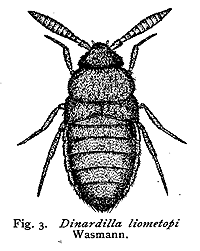 Workers are known to tend membracids and aphids. They will also visits extrafloral nectaries of some Agave, Yucca and Opuntia plants. In the case of Opuntia imbricata, Liometopum apiculatum provides protective services to the plant. Workers have been shown to be effective at reducing herbivore damage to these plants.
Workers are known to tend membracids and aphids. They will also visits extrafloral nectaries of some Agave, Yucca and Opuntia plants. In the case of Opuntia imbricata, Liometopum apiculatum provides protective services to the plant. Workers have been shown to be effective at reducing herbivore damage to these plants.
Workers will follow the trails of other ant species. In concert with this behavior, workers have been observed successfully soliciting food from of Pogonomyrmex barbatus, Camponotus sayi and Solenopsis xyloni foragers.
Associates found living in the nests of Liometopum apiculatum include a cricket species and a variety of beetle species. A few of the latter are putatively obligate as they are only known from their nest association with this ant.
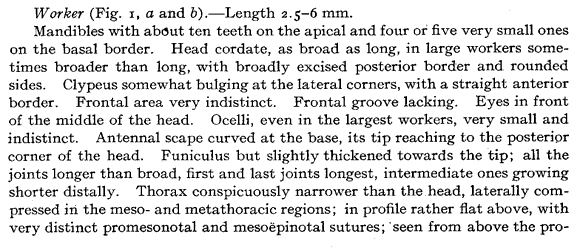
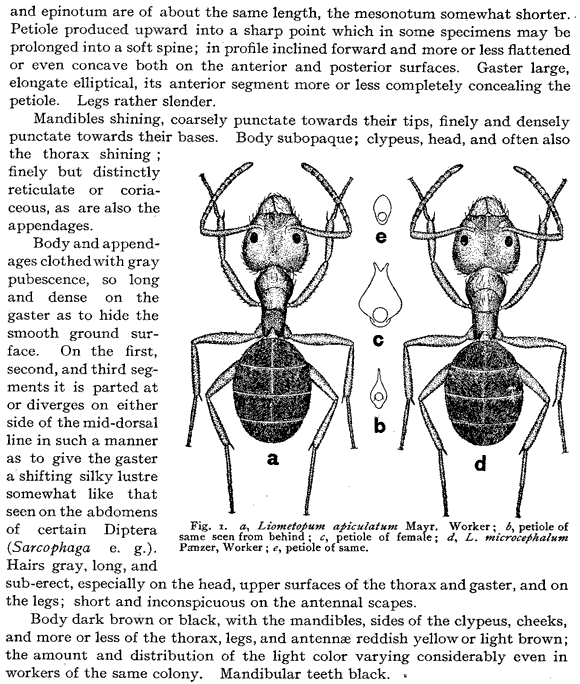
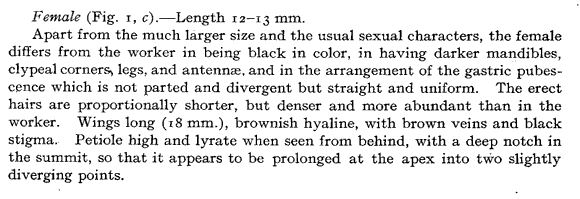
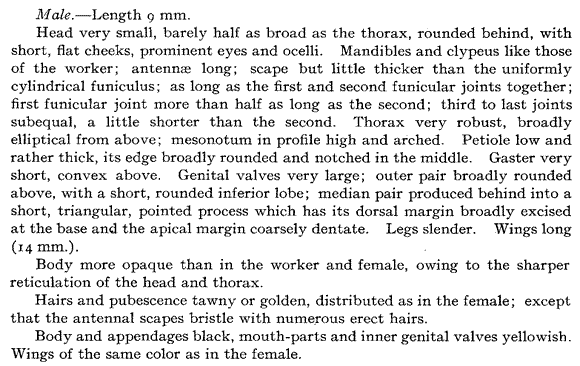
Page authored by David Lubertazzi and Gary Alpert
